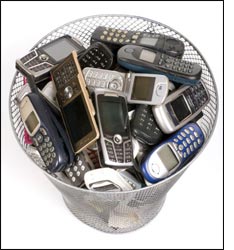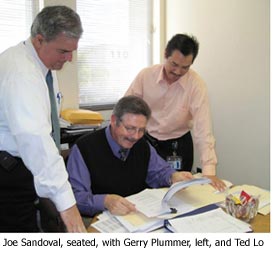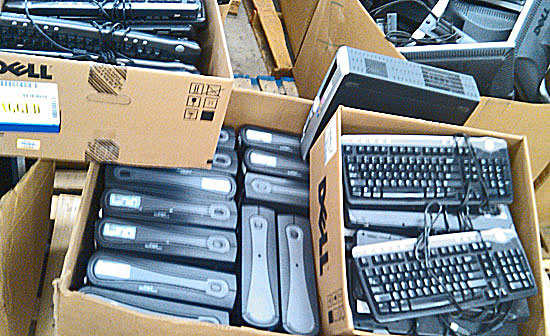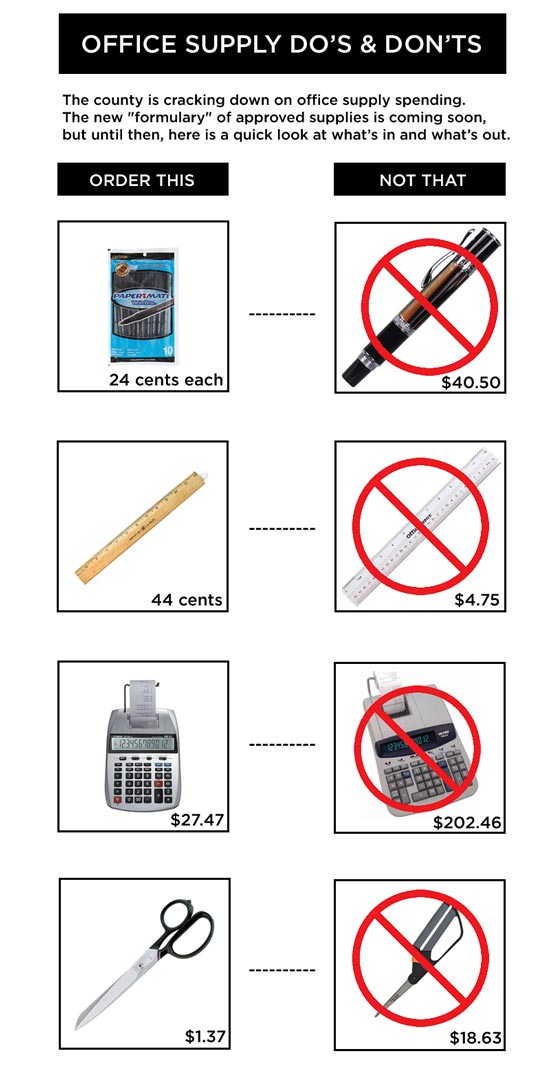Latest Audits
E-stockpile found at assessor’s office
May 3, 2012

Assessor's equipment shared space in this storage facility with the landlord's car, bikes and mattresses.
As Los Angeles County was tightening its belt in recent years, its assessor’s office was sitting on a cache of more than a half-million dollars’ worth of brand-new electronics equipment it had stockpiled but never used, a newly-released county audit found.
The auditors discovered some $654,000 worth of never-used equipment, ranging from laptops to laser jet printers, languishing in storage at the Hall of Administration after it was purchased between fiscal years 2001-2 and 2009-10.
“A lot of the equipment was still brand-new, still sealed with the original vendor tape,” said David Aldava, an intermediate accountant-auditor who was part of the team that looked into technology in the assessor’s office.
Aldava’s team also made another unusual discovery: The department had improperly stashed pallets loaded with other computers, printers and tech equipment—some still functioning, some headed to the junk pile—in an unlocked, leased storage facility in Signal Hill, where the county-owned equipment shared space with the landlord’s car, bicycles, refrigerators, mattresses and even a bar sign or two.
The equipment ended up in the storage facility—next to the assessor’s South District office—after employees initially told auditors that the department had no surplus electronics. Eventually, though, the staff “told us that they had previously moved the surplus items from other locations to the storage building in an attempt to hide the equipment from us,” according to an April 13 report from Auditor-Controller Wendy Watanabe.
In a response to the audit filed last month, the department concurred with virtually all of the auditor’s 25 recommendations, most aimed at tightening accountability, record-keeping and security and ensuring that IT equipment is purchased only when needed.
Assessor’s spokesman Louis Reyes said the office is “fully cooperating” in correcting problems uncovered in the audit. “The assessor wants to address these concerns fully,” he said.
Assessor John R. Noguez was elected in November, 2010, and was not in charge during the period in which the new equipment was stockpiled, Reyes noted.
The audit comes as a separate, broader review, ordered by the Board of Supervisors, is underway to examine how the assessor’s office operates across the board. The office has come under fire for allegedly granting preferential treatment to some property owners. Noguez also shocked the supervisors recently when he disclosed a large, unprecedented disparity in property tax projections that could leave the county with a $50 million hole in its budget.
The technology audit, conducted last year and provided to the Board of Supervisors last month, offered its own set of unexpected discoveries.
“This warehouse issue really took us by surprise,” Watanabe said—especially when employees initially refused to let the auditors into the Signal Hill facility, claiming it would take a month to reach the landlord and get his permission for access. “That really piqued our interest.”
It turned out that an effort was underway, apparently, to thwart auditors from discovering an abundance of surplus equipment, which is not allowed under county policy. “They started to dump everything to Signal Hill…We finally did get in and saw stacks and stacks of used computers,” Watanabe said. “They didn’t want us to see it, to cover up that they’d initially lied.”
Even as the used computer equipment was piling up, the department was also acquiring the stacks of new and unneeded electronics—apparently part of a use-it-or-lose strategy of spending IT funds at the end of fiscal years rather than allowing unspent money to revert to the Chief Executive Office’s overall county budget, the audit found.
Beyond the cost of the equipment itself, the department overpaid by not waiting to buy the items until they were actually needed. Because technology prices tend to decrease over time, the assessor’s office ended up paying at least $93,000 more than it should have, the audit found.
Despite the huge build-up in excess tech equipment being stored, the assessor’s office still had plenty of electronic devices to go around, it appears. The audit found that 324 of the department’s 1,425 employees had at least two computers assigned to them—and 57 had three or more.
“To us, this is just ridiculous,” Watanabe said. “There’s really no business reason to justify why someone would have three or more computers.”
The employees themselves admitted as much to county auditors when asked about those second or third computers.
“Oh, yeah, it’s just sitting in my trunk,” some said when questioned about laptops they’d been issued, according to Watanabe.
Having an unused laptop lying around the house or car has hidden costs, too, Watanabe said, since the county pays virtual network fees of $600 a year for each employee who logs onto the network from outside the office—whether a device is being used or not.
Then there were security lapses. The audit said that the assessor’s department disposed of some surplus equipment without first erasing county information from the devices’ hard drives. It also found that 22% of the department’s computers didn’t have any working anti-virus protection.
Although Watanabe said no fraud was uncovered, the audit found a system of lax controls and a cavalier attitude toward safeguarding county property.
As for the surplus devices stashed in Signal Hill, those have all been junked or donated since the audit, or will be soon, according to the department. And employees in the assessor’s office have begun working their way through that unused stockpile of new equipment.
Posted /3/12
Audit calls out DCFS cell phone abuse
December 21, 2010
 The Los Angeles County Department of Children and Family Services dialed up at least $514,000 in “potentially unnecessary and inappropriate” cell phone service charges in 2009—part of a pattern of loose oversight and lax management of the phones uncovered in a new county audit.
The Los Angeles County Department of Children and Family Services dialed up at least $514,000 in “potentially unnecessary and inappropriate” cell phone service charges in 2009—part of a pattern of loose oversight and lax management of the phones uncovered in a new county audit.
The report, released today by Auditor-Controller Wendy L. Watanabe, found that the department, which spends $2.2 million a year on cell phone services, had at least 250 phones for which it could not identify the users. It also paid monthly service fees for more than 1,400 cell phones and 220 broadband cards that were sitting idle in 2009.
Moreover, the department footed the bill for employees’ personal international long distance charges as well as other potentially inappropriate charges for roaming, directory assistance and call forwarding.
“Our review disclosed significant weaknesses in DCFS’ controls over its cell phones,” Watanabe said in a summary of the audit’s findings filed with the Board of Supervisors.
Watanabe’s report to supervisors said that the department’s management already is beginning to take corrective action by updating their cell phone inventory, cancelling service for unused phones and changing the ways in which they review monthly bills.
Among the questionable cell phone use cited in the audit:
–One employee racked up more than $2,000 in personal international long distance bills between December, 2008, and November, 2009, and did not reimburse the department.
–Another claimed to have lost her phone but didn’t report it missing. Over the course of 14 months, the department paid $8,000 in service charges on the phone, including roaming charges from Mexico.
–An employee ran up $2,827 in texting charges from December, 2008 through November, 2009. In all, the department paid $21,000 for employee texting in 2009.
–Employees dialing directory assistance from their cell phones cost the department more than $54,000 in 2009, and $9,000 for call forwarding charges between December, 2008 and November, 2009. A single employee accounted for $2,533 of the call forwarding charges during that period.
The audit recommends that DCFS management begin keeping an accurate cell phone inventory, including up-to-date records on who’s using the phones. It also urges the department to deactivate unassigned and unused phones and broadband cards and to institute monthly reviews of cell phone and broadband bills.
And it recommends tighter controls to ensure that extras such as directory assistance and texting are needed—and that employees who use those services for non-business purposes reimburse the county.
Posted 12/21/10
Audit released on “alleged intrusion” by Board deputies
February 26, 2010
Following his termination as head of the County’s Department of Regional Planning, former director Bruce McClendon stated publicly that his firing was in retaliation for protesting what he alleged was improper influence over his department by the board and its staff. The county commissioned an independent audit by Harvey M. Rose Associates to investigate McClendon’s charges.
The Rose report examined eight specific allegations, finding five of them “not substantiated” and three “not substantiated, with qualifications.” The full report may be found on the County Auditor-Controller’s site, here.
Posted 2/26/10
The $1.8 million office supply diet
February 9, 2010
 Somewhere out there in the vast universe of Los Angeles County office supplies, a Mini-Jeweleria brown resin fountain pen ($40.50) is feeling the heat right about now.
Somewhere out there in the vast universe of Los Angeles County office supplies, a Mini-Jeweleria brown resin fountain pen ($40.50) is feeling the heat right about now.
So is the Victor 12-Digit Heavy-Duty Two-Color Printing Calculator ($202.46), the Deflect-O® Execumat Heavy-Duty Vinyl Chairmat For High-Pile Carpets ($131.54) and a certain aluminum beveled edge ruler ($4.75). All have been purchased by various departments in favor of far cheaper versions of similar products available through the county’s massive office supplies contract.
No more. As county belt-tightening shifts into high gear—and nearly a year after departments were originally asked to switch to cheaper office supply alternatives—the Chief Executive Office is getting ready to draw a line in the supply closet. And not with some expensive gel ink rollerball pen, either.
Led by Joe Sandoval, the county’s general manager of Purchasing and Contract Services, a team of Internal Services Department employees has been going line-by-line through 18,000 items currently offered as purchase options under the county’s Office Depot contract. The goal is to establish a narrower range of reasonably-priced items in a “formulary” that employees will be required to use when ordering supplies. (See graphic below).
Sandoval says he is not fixated on price as the only consideration. “A 12-cent pen is better than a 5-cent pen,” he acknowledges. But he says that having too many choices of writing implements can lead to some bad decisions.
As for who’s buying $18.63 scissors when there are $1.37 scissors to be had, Sandoval prefers not to name any supply scofflaws. “I don’t want to hang any departments out,” he says.
The interest in reining in the county’s $6 million-a-year office supply habit comes against a backdrop of a countywide push for greater efficiency in a tough economy. A pilot program was launched last year, for example, to use remanufactured toner cartridges, saving $23,847 and prompting a countywide switch to such cartridges for black and white desktop printers and copiers.
There’s also an insider’s website tracking efforts to save money and streamline operations across a wide range of departments. The site features an employee suggestion box, which has attracted 238 entries since October.
As for office supplies, the buy-cheaper memo from county CEO William T. Fujioka last March made the case that simply purchasing less expensive pens could yield a savings of $162,000 a year. A purchasing bulletin issued shortly after provided guidance on the right price point on dozens of items—from butterfly clamps and erasers to rubber bands and steno pads.
But a Jan. 25, 2010, memo from Fujioka announcing the formulary plan pointedly noted the “need for greater departmental attention to purchasing low cost office products.”
Sandoval estimates that the county has saved about $500,000 on supplies in the past 12 months. But he thinks it can do so much better.
“We’re looking at a 30% savings when we complete the 18,000 line items,” he says. “That’s a significant savings.” (A cool $1.8 million a year, in case you don’t have your county-approved calculator handy.)
“It’s the best bang for the taxpayer’s buck—that’s the philosophy,” says Sandoval, 52, a 19-year ISD employee and former member of the Air Force’s security police. “That’s what I’m here for.”
He will allow that out there in “Departmentland,” people can be so focused on their “core businesses” that adopting thrifty purchasing habits is not necessarily their highest priority.
And that’s where the new online formulary comes in.
The work on the project—by a team including Gerry Plummer, division manager of purchasing, and Ted Lo, purchasing and contract analyst—should be finished within the next month or so.
When the 9,000 or fewer approved supplies are listed, catalog-style, in the county’s “procurement module,” anyone who goes in to order will see a pull-down menu of just the right choices—not the extravagant ones.
“They won’t be able to see that $32 pen,” Sandoval says.













 405 bridge work causes a stink
405 bridge work causes a stink
